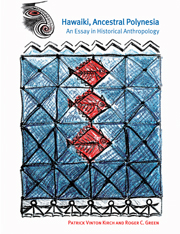Book contents
- Frontmatter
- Contents
- List of figures
- List of tables
- Preface
- List of language abbreviations
- Prologue: on historical anthropology
- Part I The phylogenetic model: theory and method
- Part II Rediscovering Hawaiki
- Introductory remarks
- 4 The Ancestral Polynesian world
- 5 Subsistence
- 6 Food preparation and cuisine
- 7 Material culture
- 8 Social and political organization
- 9 Gods, ancestors, seasons and rituals
- Epilogue: on history, phylogeny, and evolution
- Notes
- Glossary of terms
- References
- Subject Index
- Index of Proto Polynesian Reconstructions
7 - Material culture
Published online by Cambridge University Press: 06 January 2010
- Frontmatter
- Contents
- List of figures
- List of tables
- Preface
- List of language abbreviations
- Prologue: on historical anthropology
- Part I The phylogenetic model: theory and method
- Part II Rediscovering Hawaiki
- Introductory remarks
- 4 The Ancestral Polynesian world
- 5 Subsistence
- 6 Food preparation and cuisine
- 7 Material culture
- 8 Social and political organization
- 9 Gods, ancestors, seasons and rituals
- Epilogue: on history, phylogeny, and evolution
- Notes
- Glossary of terms
- References
- Subject Index
- Index of Proto Polynesian Reconstructions
Summary
Although we can look to archaeology to confirm the hypothesis that durable artefacts will be found in sites associated with Oceanic-speaking communities, there is little hope of archaeological recovery of the perishable artefacts in question. Here linguistics adds an extra dimension to research on the prehistory of Oceania.
osmond 1996:130Material culture and technology are cultural domains central to archaeology. Indeed, until the expansion of archaeological interests to incorporate “ecofacts” and other non-artifactual evidence, largely associated with the New Archaeology, the classification and analysis of material culture occupied the vast majority of archaeologists' time (Lyman et al. 1997:121–205). In Polynesia, where ceramics were absent in the ethnohistoric record, archaeologists focused their efforts on studying and classifying stone tools, especially adzes but also a range of other types including pounders (e.g., Brigham 1902; Duff 1959; Garanger 1967; see Cleghorn 1984 for a review of Polynesian adz studies). Later, when stratigraphic excavations began in Eastern Polynesia, much attention was paid to stylistic variation in fishhooks made of bone and shell, for these offered potential as chronological indicators (e.g., Emory et al. 1959; Suggs 1961). Only when excavations commenced in the Western Polynesian homeland was it discovered that ceramics, too, had once been part of the original Polynesian material culture, providing a critical linkage connecting early stages of Polynesian culture with the antecedent Lapita cultural complex (Golson 1961; Green 1974a).
Given this long and rich tradition of Polynesian archaeological studies of portable artifacts, one might suppose that archaeological evidence would occupy pride of place when applying a triangulation approach to recover the material basis of Ancestral Polynesian culture.
- Type
- Chapter
- Information
- Hawaiki, Ancestral PolynesiaAn Essay in Historical Anthropology, pp. 163 - 200Publisher: Cambridge University PressPrint publication year: 2001



